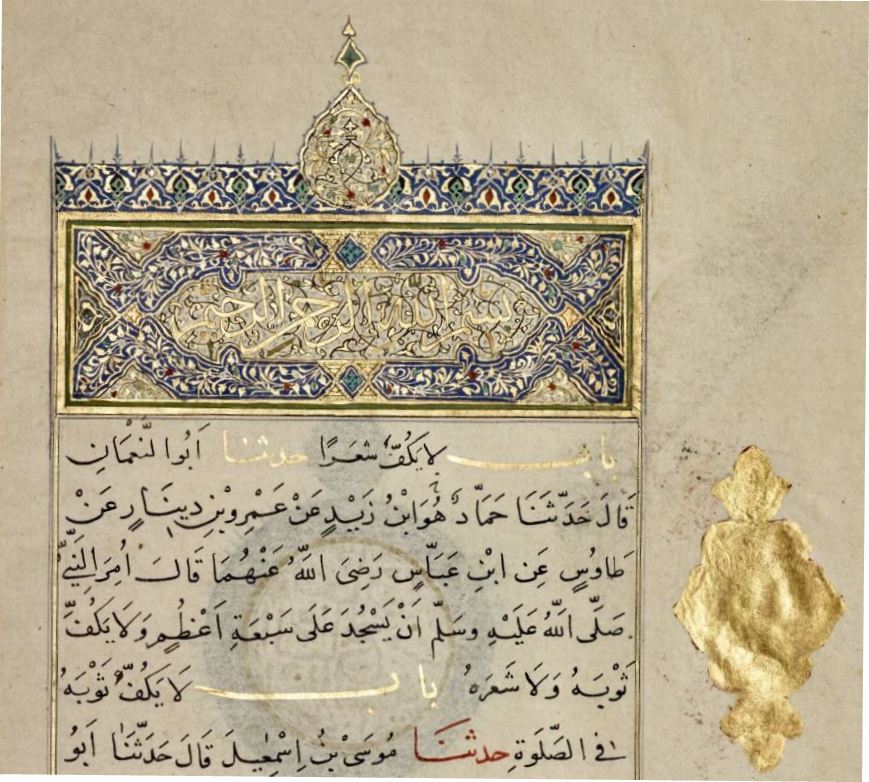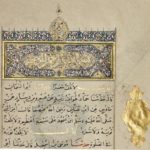
One of the means used to lead the herd that follows them is the use of parallel texts attributed to the Prophet Muḥammad and turned into a (second) revelation. These texts are used to prohibit or permit things but without adhering to the rules that have stipulated in the Qur’ānic text. These hadiths are collected together in six officially approved books termed by the Sunnīs Al-Ṣiḥāḥ and Al-Sunan, in addition to four works used by the Shi’a.
LET US TAKE A LOOK at what the writings of these two denominations say about these ten books and make a judgment as to whether these constitute valid sources meriting the status of a ‘second revelation’.
1 – The Ṣaḥīḥ of al-Bukhārī
The full name for this work is: Al-Jāmi‘ al-Musnad al-Ṣaḥīḥ al-Mukhtaṣar min Umūr Rasūl Allāh wa-Sunanihi w-Ayyāmihi (‘The Abridged Authentic Source-Verified Collection of Matters Pertaining to the Messenger of God, his Practices and his Times’). According to Ibn al-Ṣalāḥ the number of hadiths in al-Bukhārī’s collection totalled 7,275, including repeated hadiths. If we omit these, the total according to al-Nawawī stands at 4,000. Ibn Ḥajar al-‘Asqalānī disagrees and puts it at 2,761. In his work Ta‘rīf Ahl al-Taqdīs bi-Marātib al-Mawṣūfīn bi-Tadlīs,[i] (‘Identifying the Sacralisers among the Ranks of Fraudsters’) Ibn Ḥajar classes al-Bukhārī as among the top level of fraudsters, citing Abū ‘Abd Allah ibn Manda who described him as such.
2 – The Ṣaḥīḥ of Muslim
This work is known under various names, such as Al-Musnad al-Ṣaḥīḥ, or Al-Musnad, or Al-Jāmi‘ al-Ṣaḥīḥ. It was written by Muslim ibn al-Ḥajjāj al-Nīshābūrī, (ob. 261 AH). It contains 7,275 hadiths chosen from some three hundred thousand hadiths. Ibn Ḥajar al-‘Asqalānī in his work: Al-Wuqūf ‘alā mā fī Ṣaḥīḥ Muslim in al-Mawqūf (‘On Mawqūf hadiths contained in the Ṣaḥīḥ Muslim’) [ii] lists 192 interrupted or ‘stopped’ chains of narration contained in Muslim’s Ṣaḥīḥ. He also highlighted 14 ‘hanging’ hadiths[iii] in the work. In some places outright fraud was detected. There are also some unknown narrations in this work. Al-Dhahabī in his Siyar A‘lām al-Nubalā’ (‘Biography of the Nobles’) notes Sa‘īd al-Barda‘ī’s comment that Abū Zarā‘a had spoken to him of Muslim’s Ṣaḥīḥ saying:
“These people were keen to advance themselves before their time, so they created something they could market by writing some unprecedented work so as to achieve some premature prominence.” He went on to say that he was present when a man brought out a copy of Muslim’s work and they dipped into it and found the hadith related by Asbāṯ ibn Naṣr, whereupon Abū Zarā‘a exclaimed: “This is about as far as one could get from a sound hadith! Asbāṯ ibn Naṣr has been included in this work!” He then also saw that Qaṭan ibn Nusayr had also been included and said: “This is even worse!” [iv]
3– The Sunan of Abū Dāwūd
The author of this book is Sulayman ibn al-Ash‘ath, known as Abū Dāwūd al-Sijistānī (ob. 277 AH), The Sunan of Abū Dāwūd is divided into 40 books containing 5,274 hadiths, and includes a wide range of topics such as the topic of Al-Mahdi, the study of epic battles and the issue of breastfeeding adults. Many of the hadiths in this book are defamatory and denigrated by Sunni scholars themselves, with some senior Sunnis even holding that it contains weak hadiths, or even many outright forged hadiths. For example, Ibn al-Jawzī mentions some of these hadiths in his book Al-Mawḍū‘āt (‘Forged hadiths’), and Muḥammad Nāṣir al-Albānī has authored a work under the title The Weak hadiths of Abū Dāwūd. In this work Al-Albānī attempted to identify the weak hadiths contained in the Sunan of Abū Dāwūd, and he found that 800 of its hadiths were weak. He also held that it contained 50 repudiated hadiths and 50 ‘odd’ hadiths.
Many of the hadiths in this book are defamatory and denigrated by Sunni scholars themselves
4 – The Sunan of Al-Tirmidhī
The author of this work, Muḥammad ibn ‘Īsā al-Tirmidhī, (ob. 279 AH) was one of al-Bukhārī’s disciples. He wrote 46 books and some of the hadiths contained in the Sunan al-Tirmidhī are unknown and falsely attributed to the Prophet. Ibn al-Jawzī and some other senior Sunni scholars also held that the work contained hadith by unknown transmitters.
5 – The Sunan of Al-Nisā’ī
In this collection by Abū ‘Abd al-Raḥmān Aḥmad ibn ‘Alī ibn Shu‘ayb al-Nisā’ī (ob.303 AH) there are many weak narratives. Ibn Qayyim al-Jawziyya cited hadiths from al-Nasā’ī’s work in his book Zād al-Ma‘ād fī Hudā Khayr al-‘Ibād and mentions how the major Sunni scholars ruled out the transmission chains of these hadiths or their text, or both of them together. As for Al-Albānī, he cites more than 80 weak hadiths in his work (Ṣaḥīḥ wa-Ḍa‘īf Sunan al-Nisā’ī).
6 – The Sunan of Ibn Mājah
The author of this book is Muḥammad ibn Yazīd ibn Mājah al-Qazwīnī (ob. 273 AH). The work contains 4,000 hadiths, including 428 authentic hadiths, 199 ḥasan (‘good’) hadiths, 613 weak hadiths and 99 repudiated hadiths. Many Sunni scholars believe that Ibn Mājah’s book is fraught with weak and fabricated hadiths. Al-Albānī, for example, criticized Ibn Mājah in his book Ḍa‘īf Sunan Ibn Mājah as did ‘Abd al-Bāqī in his Mafātīḥ al-Sunan. This is why some Sunnis hold that the Sunan of Ibn Mājah does qualify to be one of the six major Ṣaḥīḥ collections, and put Mālik’s Muwaṭṭa’ in its place in the ranking.

Suggested Reading
As for the Shi‘ites, they have four works of hadith: Al-Kāfī , Man lā Yaḥḍuruhu Faqīh, Al-Istibṣār and Al-Tahdhīb. In his work Ma‘ālim al-Madrasatayn Sayyid Murtaẓa al-‘Askarī says the following:
The oldest and most celebrated of the four works is the Al-Kāfī by Shaykh al-Kulaynī. Hadith scholars of the Ahl al-Bayt school state that it contains 9,485 weak hadiths out of a total of 16,121 in the work. If you consult the commentary on this collection entitled Mir’āt al-‘Uqūl you will find its author Al-Majlisī – one of the great hadith scholars – saying that, in his evaluation, the author’s assessment of weak hadiths in Al-Kāfī itself weak, as is his evaluation of the number of sound, authenticated or strong hadiths. Sayyid al-Khoei, in his Mu‘jam Rijāl al-Ḥadīth classified the narrations given in the four books as unreliable and affirmed that Shaykh al-Ṭūsī, and Al-Ṣaddūq, along with his shaykh, did not consider any of the hadith mentioned in Al-Kāfī as valid. He also mentions that Shaykh al-Ṭūsī did not view all of the hadith mentioned in Man lā Yaḥḍuruhu Faqīhas validated. More importantly, Al-Kulayni himself did not view every hadith collected in his Al-Kāfīas sound. Similarly, Al-Ṣaddūq did not see every hadith collected in Man lā Yaḥḍuruhu Faqīh as sound either. As for the works Al-Tahdhīb and Al-Istibṣār Shaykh al-Ṭūsī similarly declined to see every hadith included as valid hadiths.
[i] Ibn Ḥajar al-‘Asqalānī, تعريف اهل التقديس بمراتب الموصوفين بالتدليس ed. Asim bin Abdullah Al-Qaryouti, Al-Manar Library Publications, 1980, p.24.
[ii] The term mawqūf refers to hadith that cannot be authoritatively ascribed to the Prophet since the chain of transmission is ‘stopped’ at the level of a Companion to the Prophet). See Glossary ‘hadith’ for a list of some of the categories.
[iii] Muʽallaq (‘hanging’ in that the tradition is unsupported by any isnād at all and is simply a purported ‘quotation’ from the Prophet.
[iv] Al-Dhahabī, سير اعلام النبلاء, Part 12, p.571.
Main image: The ḥadīth considered as a text ranking with Qur’anic scripture: a muṣḥaf-like page from the Ṣaḥīḥ al-Bukhārī with gold illumination. The passages calligraphically inscribed are Ḥadīths 815 and 816 from chapter كتاب الأذان : “The Prophet was ordered to prostrate on seven bony parts and not to tuck up his clothes or hair” (when performing ṣalāh). Unknown artist, Shiraz, dated 1400-1450. From the Keir Collection of Islamic Art, Object number K.1.2014.800.1.
